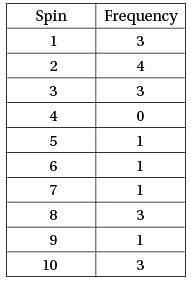SAT Exam > SAT Questions > The spinner for a board game has 10 sectors, ...
Start Learning for Free

The spinner for a board game has 10 sectors, numbered 1 through 10. It is spun 20 times and the results summarized in the table above. What is the median value of these 20 spins?
- a)2
- b)4
- c)5
- d)6
Correct answer is option 'B'. Can you explain this answer?
Most Upvoted Answer
The spinner for a board game has 10 sectors, numbered 1 through 10. It...
The table summarizes the following list of 20 numbers: 1, 1, 1, 2, 2, 2, 2, 3, 3, 3, 5, 6, 7, 8, 8, 8, 9, 10, 10, 10. If a set of numbers is listed in increasing order, the median is the middle number (if the set contains an odd number of elements) or the average of the two middle terms (if the set contains an even number of elements). The median of a set of 20 numbers, therefore, is the average of the 10th and 11th terms. Since the 10th number is 3 and the 11th number is 5, the median is (3 + 5)/2 = 4.

|
Explore Courses for SAT exam
|

|
Similar SAT Doubts
The spinner for a board game has 10 sectors, numbered 1 through 10. It is spun 20 times and the results summarized in the table above. What is the median value of these 20 spins?a)2b)4c)5d)6Correct answer is option 'B'. Can you explain this answer?
Question Description
The spinner for a board game has 10 sectors, numbered 1 through 10. It is spun 20 times and the results summarized in the table above. What is the median value of these 20 spins?a)2b)4c)5d)6Correct answer is option 'B'. Can you explain this answer? for SAT 2025 is part of SAT preparation. The Question and answers have been prepared according to the SAT exam syllabus. Information about The spinner for a board game has 10 sectors, numbered 1 through 10. It is spun 20 times and the results summarized in the table above. What is the median value of these 20 spins?a)2b)4c)5d)6Correct answer is option 'B'. Can you explain this answer? covers all topics & solutions for SAT 2025 Exam. Find important definitions, questions, meanings, examples, exercises and tests below for The spinner for a board game has 10 sectors, numbered 1 through 10. It is spun 20 times and the results summarized in the table above. What is the median value of these 20 spins?a)2b)4c)5d)6Correct answer is option 'B'. Can you explain this answer?.
The spinner for a board game has 10 sectors, numbered 1 through 10. It is spun 20 times and the results summarized in the table above. What is the median value of these 20 spins?a)2b)4c)5d)6Correct answer is option 'B'. Can you explain this answer? for SAT 2025 is part of SAT preparation. The Question and answers have been prepared according to the SAT exam syllabus. Information about The spinner for a board game has 10 sectors, numbered 1 through 10. It is spun 20 times and the results summarized in the table above. What is the median value of these 20 spins?a)2b)4c)5d)6Correct answer is option 'B'. Can you explain this answer? covers all topics & solutions for SAT 2025 Exam. Find important definitions, questions, meanings, examples, exercises and tests below for The spinner for a board game has 10 sectors, numbered 1 through 10. It is spun 20 times and the results summarized in the table above. What is the median value of these 20 spins?a)2b)4c)5d)6Correct answer is option 'B'. Can you explain this answer?.
Solutions for The spinner for a board game has 10 sectors, numbered 1 through 10. It is spun 20 times and the results summarized in the table above. What is the median value of these 20 spins?a)2b)4c)5d)6Correct answer is option 'B'. Can you explain this answer? in English & in Hindi are available as part of our courses for SAT.
Download more important topics, notes, lectures and mock test series for SAT Exam by signing up for free.
Here you can find the meaning of The spinner for a board game has 10 sectors, numbered 1 through 10. It is spun 20 times and the results summarized in the table above. What is the median value of these 20 spins?a)2b)4c)5d)6Correct answer is option 'B'. Can you explain this answer? defined & explained in the simplest way possible. Besides giving the explanation of
The spinner for a board game has 10 sectors, numbered 1 through 10. It is spun 20 times and the results summarized in the table above. What is the median value of these 20 spins?a)2b)4c)5d)6Correct answer is option 'B'. Can you explain this answer?, a detailed solution for The spinner for a board game has 10 sectors, numbered 1 through 10. It is spun 20 times and the results summarized in the table above. What is the median value of these 20 spins?a)2b)4c)5d)6Correct answer is option 'B'. Can you explain this answer? has been provided alongside types of The spinner for a board game has 10 sectors, numbered 1 through 10. It is spun 20 times and the results summarized in the table above. What is the median value of these 20 spins?a)2b)4c)5d)6Correct answer is option 'B'. Can you explain this answer? theory, EduRev gives you an
ample number of questions to practice The spinner for a board game has 10 sectors, numbered 1 through 10. It is spun 20 times and the results summarized in the table above. What is the median value of these 20 spins?a)2b)4c)5d)6Correct answer is option 'B'. Can you explain this answer? tests, examples and also practice SAT tests.

|
Explore Courses for SAT exam
|

|
Signup for Free!
Signup to see your scores go up within 7 days! Learn & Practice with 1000+ FREE Notes, Videos & Tests.


























